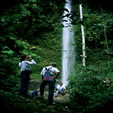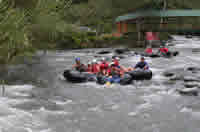 |
Protected
Areas
The 655,781 ha Cuyabeno Fauna Production Reserve, located in northeastern
Sucumbíos, is one of the Amazon Rain Forest’s most biologically
rich areas. Located between the San Miguel and Aguarico river basins,
Cuyabeno’s endless stretches of lakes, rivers, and tropical
forests are home to countless species of mammals, insects, reptiles,
aquatic life, and rare and endangered species birds. Cuyabeno is
also a caiman reserve. The Reserve is generally reached by navigating
down the Aguarico or Cuyabeno rivers. Tours of the Reserve can be
arranged with local guides in nearby Nueva Loja (more commonly known
as Lago Agrio) or in a variety of other towns and cities: Quito,
Baños, Missahuallí, etc.
Another protected area worthy of noting in the Ecuadorian Amazon
Rain Forest is the Limoncocha Biological Reserve. Among Limoncocha’s
principal attractions are Limoncocha Lake, the Reserve’s primary
and secondary forests, and the area’s spectacular wildlife,
which includes 350 unique species of birds and countless reptile
and mammal species. The Reserve is perhaps best known for its large
black caiman population. The Reserve can easily be accessed from
the province’s capital city of Nueva Loja (Lago Agrio).
In the province of Napo, along Ecuador’s eastern border with
Peru, you’ll find the 982,000 ha. Yasuní National Park.
This extensive park is home to a variety of vegetation types (dense
tropical forest, swamplands, rolling hills, etc.) and a plethora
of wildlife (jaguars, harpy eagles, and caimans, to name a few).
The hot and humid region is traversed principally by water and is
a popular destination for scientists and adventurers from all over
the world.
One of the southern Ecuadorian Amazon’s principal attractions
is Condor National Park, in the province of Morona Santiago. Rich
in biological diversity, the Park is home to 127 mammal species
and countless species of flora. The park is situated to the west
of the eastern range of the Andes and to the east of the Huaracayo
Range. Due to the geological origins of the Condor Range, there
are extensive hydrographic systems present that form the basins
of the Zamora, Santiago, Coangos and Namangoza Rivers. In Zamora
Chinchipe, Podocarpus National Park arises imposingly, giving way
to cloud forests, rivers, and numerous species of birds. Covering
over 146,200 ha., the park is located on the border of the provinces
of Loja and Zamora. Its altitude varies from one to three thousand
meters, with its temperatures oscillating between 8 and 20 degrees
centigrade. The territory is home to over 100 lakes. There are also
waterfalls, canyons, and various kinds of mammals and plants. This
reserve was established with the mission of protecting the Podocarpus
trees that grow in the park. Among the main activities available,
to better experience the area’s natural setting, are walks
and treks during which one can admire the spectacular scenery filled
with orchids and multi-colored birds.
TOP
Private
Reserves
In the province of Napo, we find the Jatun Sacha Biological Research
Center, cared for and administrated by the ecological organization
of the same name. It contains abundant flora and fauna typical of
tropical rain forests of the Amazon. Many species of amphibians
and birds have been identified in this area. There are many trails
along which tourists can explore the area.
TOP
Sports
and Adventure Tourism
 |
The most popular sports in the region
are rafting and kayaking, chosen by those looking for the maximum
in adventure in the middle of a paradise of pure and crystal waters.
In the Napo, Misahuallí, Hollín, or Calmitoyacu, near
the 16th century town of Archidona, it is easy to find underground
rivers, cracks, passageways, and impressive caves among the powerful
waters that run through the Amazon jungle.
In Tena, the capital city of the province of Napo, there is a large
concentration of rivers with many facilities for practicing water
sports. You can choose between calm routes and the excitement offered
by heavy rapids. Another popular trip made by tourists is along
the Upano River in southern Ecuador in the province of Morona Santiago.
Ecuador offers schools and instructors to help facilitate these
activities. In the Casanga and Quijos Rivers of Baeza (Napo) or
in the Lake of Lago Agrio (Nueva Loja, Sucumbíos), you can
do some great fishing. The main travel agencies in the country’s
major cities, including the capitals of the Amazon provinces, will
help to organize any trip or tour desirable. To participate in any
high risk sports such as kayaking or rafting, you need to have a
specialized guide who knows the river and jungle territories.
TOP
| Protected
Areas | Private Reserves |
| Sport and Adventure Tourism |
|

